Simple Summary
Although the use of antimicrobials and the related selection of antimicrobial-resistant (AMR) pathogens are recognized worldwide, limited or no information is available on the effect of the antibiotic treatment on the genetic structure as well as the dissemination and persistence of plasmids carrying AMR genetic determinants. This is of particular interest for bacterial pathogens like Avian Pathogenic Escherica coli (APEC), which have the potential to persist and be transmitted from broilers to humans through the food chain as well as for their AMR genetic determinants, which have the potential to be mobilized and spread. With a genomic approach, results of the present study revealed that during the enrofloxacin treatment of broilers, initial strains of extraintestinal E. coli disappeared, being substituted by new clones. Plasmid-mediated fluoroquinolone resistance did not appear to disseminate or persist among observed genomes, confirming that QRDR mutations rather than plasmids are the main drivers of quinolone resistance. Interestingly, plasmids carrying other AMR genes than quinolone-determinant ones were disseminated and persistent since they were found in different clones both before and after the treatment. The persistence of plasmids without a direct antimicrobial selective pressure, if confirmed with further studies, might give insights on the so-called plasmid paradox.
Abstract
The aim of the present study was to investigate the genetic diversity and antimicrobial resistance (AMR) of E. coli during enrofloxacin therapy in broilers affected by colisepticemia. Three unrelated farms with ongoing colibacillosis outbreaks were sampled at day 1 before treatment and at days 5, 10 and 24 post-treatment. A total of 179 E. coli isolates were collected from extraintestinal organs and submitted to serotyping, PFGE and the minimum inhibitory concentration (MIC) against enrofloxacin. PFGE clusters shifted from 3–6 at D1 to 10–16 at D5, D10 and D24, suggesting an increased population diversity after the treatment. The majority of strains belonged to NT or O78 and to ST117 or ST23. PFGE results were confirmed with SNP calling: no persistent isolates were identified. An increase in resistance to fluoroquinolones in E. coli isolates was observed along the treatment. Resistome analyses revealed qnrB19 and qnrS1 genes along with mutations in the gyrA, parC and parE genes. Interestingly, despite a fluoroquinolone selective pressure, qnr-carrying plasmids did not persist. On the contrary, two conjugative AMR plasmid clusters (AB233 and AA474) harboring AMR genes other than qnr were persistent since they were identified in both D1 and D10 genomes in two farms. Further studies should be performed in order to confirm plasmid persistence not associated (in vivo) to antimicrobial selective pressure.
1. Introduction
Escherichia coli is a commensal bacterium of the gastrointestinal tract of humans and animals. However, in some circumstances, E. coli can cause extraintestinal diseases. In broilers, colibacillosis is localized or systemic and it is associated with post-mortem lesions such as airsacculitis, pericarditis, perihepatitis and peritonitis [1]. This disease causes significant economic losses for world poultry producers [2]. Mortality rates ranging from 3.3% up to 28.3% have been registered worldwide [3,4,5,6,7,8]. In addition, an even higher concern is associated with the similarities observed between Avian Pathogenic Escherichia coli (APEC) and human pathogenic Escherichia coli, thus suggesting a zoonotic potential [9,10,11].
E. coli shows a high intra-population diversity [12,13,14,15]. In terms of the serogroup, a great variety has been described worldwide, although the primary serogroups associated with APEC include O1, O2 and O78 [16]. Serogroups O19, O35, O84, O142 and O157 were also detected among APEC isolates, although to a lesser extent [17,18,19,20]. A high rate of untypable strains was also observed [17,20]. In terms of Multi-Locus Sequence Typing (MLST), the most frequently reported sequence types (ST) were ST117, ST23 and ST350. Other ST were ST48, ST95, ST140, ST141, ST155, ST162, ST428, ST949 and ST1618 [12,16,17,21,22].
Unfortunately, the use of antimicrobials over the last few decades has resulted in the selection of multi-drug-resistant strains dramatically reducing treatment options [21,23]. In the last decade, in Italy, among 110 APEC isolated from broilers with colibacillosis, high levels of resistance were observed for sulphonamides (76.4%), streptomycin (62.7%) and sulphamethoxazole combined with trimethoprim (63.6%) [24]. In the same country, high rates of occurrence of resistant APEC against oxytetracycline were also described [25]. Worldwide, percentages of resistance ranging between 63.5% and 91% were reported for APEC, isolated from chickens, against ampicillin, amoxicillin, streptomycin, chloramphenicol, tetracycline, nalidixic acid and ciprofloxacin [21,26].
Although the use of antimicrobials and their effects on the selection of antimicrobial-resistant pathogens are recognized worldwide, limited or no information is available on the effect of an antibiotic treatment on the genetic structure and antimicrobial resistance patterns of a bacterial population. This is of particular interest for bacterial pathogens like APEC, which have the potential to persist and be transmitted to humans as well as for their AMR genetic determinants, which have the potential to be mobilized and spread among other Gram-negative communities.
The aim of the present study was to investigate the genetic diversity of extraintestinal E. coli populations during antimicrobial therapy in broilers affected by colisepticemia. Additionally, a selection of newly sequenced E. coli genomes of isolates collected before, during and after the treatment were compared in order to gain insights on their genomic relatedness, as well as to compare their resistome and its potential mobilization.
2. Materials and Methods
2.1. Sample Collection
Three unrelated conventional broiler farms were selected. Two farms (Farms A and C) with a daily mortality rate over 0.2%, and one farm (Farm B) with a daily mortality rate of 0.12%, were identified in Northern Italy in 2016. In all three commercial farms, broilers showed symptoms of lethargy, a lower body weight increase and gross pathological lesions related to colisepticemia. In particular, Farm B was chosen, although showing a lower percentage of the daily mortality rate, because of the evidence of clinical signs of septicaemic colibacillosis. All animals were vaccinated at the hatchery at regular doses for Newcastle disease, infectious bronchitis, Marek disease and Gumboro disease and they were fed at libitum with feed containing coccidiostats. Broilers were submitted to antibiotic treatment with enrofloxacin in drinking water at a dose of 10 mg/kg of body weight. A total of ten animals were humanely euthanized by farm veterinarians from each farm on day 1 (D1) (start of treatment and prior to first dosing), D5 (end of treatment), D10 and D24 (day 10 and 24 after treatment; D24 only in Farm B). At D1, birds were 20, 14 and 37 days old in Farm A, B and C, respectively. The production cycle lasted 37 days in Farms A and B and 45 days in Farm C. After euthanasia with cervical dislocation, gross pathological lesions of carcasses were scored and samples of the lungs, central nervous system (cns), heart (pericardium layers) and spleen were collected for E. coli isolation. All samples were collected from farm veterinarians for diagnostic purposes.
2.2. Escherichia coli Isolation
Organ samples were streaked on MacConkey agar (Thermo Scientific, Milan, Italy) for the semi-quantitative evaluation of the presence of E. coli and incubated at 37 ± 1 °C for 24 h [27]. Single colonies showing characteristic E. coli morphology were selected from each plate, inoculated in a Brain Heart Infusion Broth (BHI, Thermo Scientific) and incubated at 37 ± 1 °C for 24 h. Pure cultures were stocked and stored at −80 °C with 10% of glycerol until further use. Following, each stock culture was submitted to biochemical tests with the API system (BioMérieux, Marcy L’Etoile, Lyon, France) for species confirmation. A total of 179 E. coli isolates were selected, all belonging to different sampled organs and distributed as follows: 52 from Farm A, 70 from Farm B and 57 from Farm C. The assigned ID was built on two numbers: the first number representing the day of sampling at one of the three farms and the second related to the animal.
2.3. Serotyping
All 179 E. coli isolates underwent conventional serotyping for O antigens according to standard procedures as previously described [28]. Commercial antisera of all 188 E. coli O antigens were used (SSI Diagnostica®, Milan, Italy). To remove nonspecific agglutinins, the antisera were adsorbed with the corresponding cross-reacting antigens.
2.4. Pulse-Field Gel Electrophoresis
A total of 179 E. coli isolates underwent molecular typing with pulsed-field gel electrophoresis (PFGE). The PFGE was performed following the PulseNet standardized protocol, using Salmonella enterica serovar Braenderup H9812 as a molecular size marker and XbaI as a restriction enzyme [29]. In particular, an inactivation step against DNAse was added to the protocol as previously described [30]. After importing into Bionumerics 7.1 software (Applied Maths, Saint-Martens-Latem, Belgium), profiles were normalized and compared using the Dice similarity index, and the unweighted-pair group method using the average linkage algorithm (UPGMA) was used to create the dendrogram, with a 1.0% optimization setting and 1.2% band position tolerance. Isolates showing a 95% PFGE similarity cut-off were considered as closely related and grouped in the same PFGE cluster.
2.5. Antimicrobial Susceptibility Testing
Antimicrobial susceptibility was tested with the microbroth dilution method as reported by the Clinical and Laboratory standard Institute [31]. E. coli ATCC 25,922 was included as a quality control. Isolates were tested against enrofloxacin (ENR). Twelve serial dilutions were tested from 0.016 to 32 mg/L and the following clinical break points were used: susceptible S ≤ 0.25 mg/L, intermediate (I) if included in the range 0.5–1 mg/L and resistant R ≥ 2 mg/L.
2.6. Whole-Genome Sequencing and De Novo Assembly
Within the 179 E. coli isolates, a representative dataset of 31 isolates was selected and whole-genome sequenced. The 31 isolates were selected based on different metadata (the farm, day of sampling and anatomic portion) as well as PFGE profiles and MIC values, in order to gather a comprehensive population diversity. Genomic DNA was extracted using the MagAttract HMW DNA Kit (Qiagen, Hilden, Germany). The DNA concentration and quality parameter ratio 260/280 were measured with BioSpectrometer fluorescence (Eppendorf). Libraries were built using a Nextera® XT DNA Library Preparation Kit (Illumina, Milan, Italy) and sequenced on an Illumina MiSeq Platform, which generates tagged 250 bp paired-end reads. Reads were de novo-assembled, applying INNUca v3.2, a fully automated open-source pipeline where reads are quality checked with FASTQC, and read cleaning is performed with TRIMMOMATIC and de novo draft genome assembly is performed with SPAdes v3.9.0 [32]. Finally, the whole draft genome was improved using PILON by correcting bases and fixing misassemblies. Moreover, INNUca includes the MLST tool, which assigns the 7-loci MLST Sequence Type based on PubMLST typing schemes. Read sequences are available at the European Nucleotide Archive under the study accession number PRJEB36793.
2.7. In Silico Analyses
De novo assemblies of the 31 selected genomes were submitted to the ABRicate tool, which performs a BLAST search of genes included in specific databases [33]. The Resfinder Database was selected for the genomic characterization of the resistome. Chromosomal point mutations associated with antimicrobial resistance were investigated using ResFinder v.4.0 [34]. Abricate results were sorted and genes with an identity equal to or higher than 90% and coverage equal to or higher than 60% were retained and considered positive for the gene. FimH typing was performed using FimTyper v.1.0 [35,36]. The localization of antimicrobial resistance-determinant genes on conjugative, mobilizable or non-mobilizable plasmids or on the chromosome was investigated by using MOB-Recon tool v.3.0.1, which provided additional typing information about plasmids [37].
2.8. SNP Calling
Single nucleotide polymorphism (SNP) calling was performed with Snippy, a rapid haploid variant calling and core genome alignment open-source tool [38]. The pipeline includes several tools that align reads or assemblies from each isolate to a reference genome and then identifies variants among the alignments. Based on the core SNP alignment of the 31 E. coli isolates sequenced in the present study, a high-resolution phylogeny tree was built including the conserved nucleotide variant sites shared by all genomes. PhyML v3.3.2 was used to analyse the SNP differences between isolates based on the maximum likelihood algorithm and phylogenetic trees were visualized with iTOL [39]. Finally, a pairwise SNP distance matrix was built using snp-dists v0.6.3 [40].
2.9. Data Analysis
Data were analysed using Excel (Microsoft, 2016 version). A one-way ANOVA test was used to compare data of the three groups (D1, D5 and D10).
3. Results
3.1. E. coli Isolation
One-hundred and seventy-nine E. coli were collected as single isolates from each of the following organs: the lungs, spleen, heart and cns (Table 1). Interestingly, in the spleen, heart and cns, the number of isolated E. coli decreased significantly from D1 to D5 (p = 0.00699), which is in line with the reduction in the scores of gross pathological lesions of carcasses.

Table 1.
Number of E. coli isolates collected from colisepticemia-affected broilers.
3.2. Serotyping
Within the 179 E. coli isolates, the large majority was not typable (NT) (127) (Table 2). Among typable isolates, the serogroup most frequently identified was O78 followed by O86 (5) and O157 (3). Regarding the 40 O78 isolates, all isolated from Farm B, 36 were isolated at day 1 before antimicrobial treatment, suggesting this serogroup was the dominant strain likely infecting the flock. In the literature, the NT serogroup has already been observed as the most frequently identified APEC serogroup followed by O78 [16,17,20]. Interestingly, three isolates, collected from Farm C and isolated from the lungs, belong to serogroup O157, which includes enterohemorrhagic strains of a human health concern [41].

Table 2.
Serogroups of E. coli isolates collected from colisepticemia-affected broilers.
3.3. Pulsed-Field Gel Electrophoresis
According to PFGE, the genetic diversity was relatively low before treatment and increased thereafter (Figure 1, Figure 2 and Figure 3). Independently from the farm, at D1, E. coli isolates clustered in 3–6 clusters at a 95% similarity, whereas at D5, D10 and D24, the number of clusters increased to 10–16 with most clusters containing single isolates. Of note, more than one clone was collected at D1 in the same farm, suggesting that colibacillosis was associated with different APEC strains. Some PFGE profiles were found both in D1 and D5 isolates or D5 and D10 isolates. However, no PFGE profiles were recurrently found at all time periods, suggesting the lack of the persistence of D1 strains.
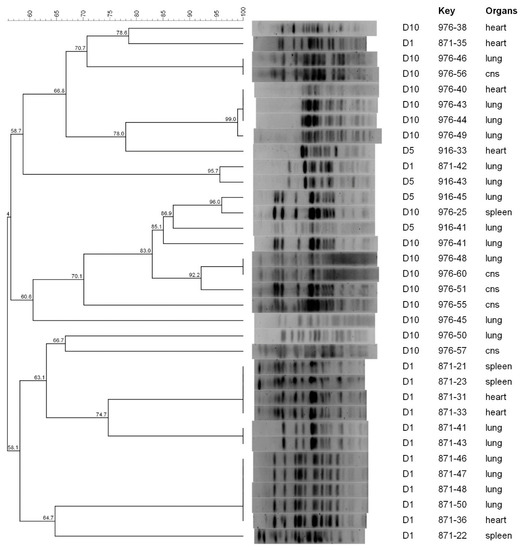
Figure 1.
PFGE dendrogram of E. coli isolates collected from broilers in Farm A.
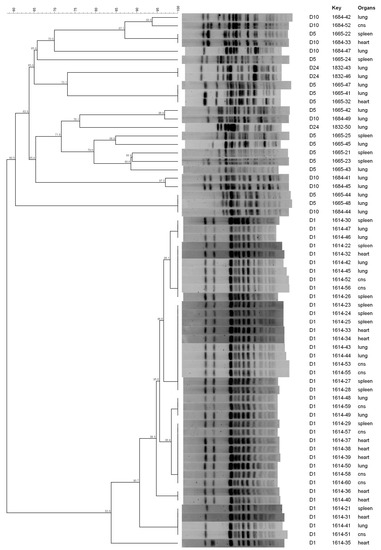
Figure 2.
PFGE dendrogram of E. coli isolates collected from broilers in Farm B.
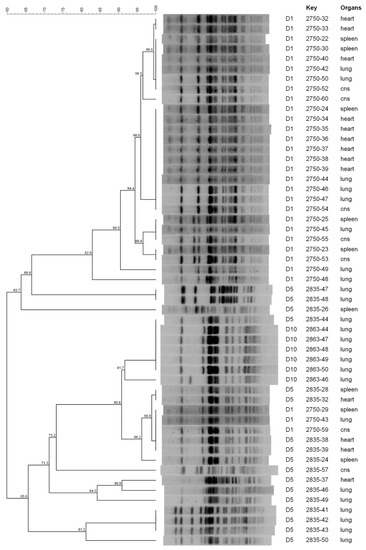
Figure 3.
PFGE dendrogram of E. coli isolates collected from broilers in Farm C.
Based on the percentage of similarity of 95%, in Farm A, E. coli isolates collected before the antibiotic treatment (D1) were grouped in 6 PFGE clusters, whereas after the antibiotic treatment (D5 and D10), 14 PFGE clusters were detected (Figure 1). One D1 isolate (871-42) showed a similar PFGE pattern to a D5 isolate (916-43) at 95,7% of similarity (both collected from the lungs), whereas no PFGE patterns were shared between D1 and D10 isolates. One D5 isolate (916-45) showed a similar PFGE pattern to a D10 isolate (976-25) with 96% of similarity. Within isolates collected after the treatment (D5 and D10), a wide diversity of PFGE profiles was identified without any correlation to the date of collection or the organ of origin (Figure 1).
In Farm B, E. coli isolates collected at D1 clustered in three PFGE clusters. In particular, two of them included isolates from different organs (the heart, spleen and lungs) (Figure 2), suggesting that the same strain colonised different organs. Isolates collected after the treatment clustered in a higher number of PFGE clusters: 10, 7 and 2 patterns for D5, D10 and D24, respectively. No similar PFGE patterns were observed between isolates collected before and after treatment (Figure 2). Although, after the treatment, four D5 isolates (1665-22, 1665-42, 1665-44 and 1665-48) showed a similar PFGE pattern to D10 isolates (1684-33, 1684-49 and 1684-44) with similarities ranging from 96.8 to 100%.
In Farm C, E. coli isolates belonging to D1 clustered in 4 different patterns, whereas 11 different patterns were identified for D5 and D10. Three D1 isolates (2750-29, 2750-43 and 2750-59) shared the same PFGE profile as two D5 isolates (2835-38 and 2835-39) and showed a similarity of 98.9% with two additional D5 isolates (2835-28 and 2835-32). Moreover, one D5 isolate (2835-44) showed the same PFGE profile as five D10 isolates (2863-44, 2863-47, 2863-48, 2863-49 and 2863-50) (Figure 3).
In all three farms, no PFGE profiles persisted along the time of sampling (D1-24), suggesting that initial pathogenic D1 isolates disappeared, being effectively eradicated by the antimicrobial treatment and substituted by new isolates.
3.4. Minimal Inhibitory Concentration (MIC)
MIC values of 179 E. coli isolates against enrofloxacin are reported in Table 3. Not surprisingly, before the antibiotic treatment at D1, the majority of isolates were susceptible to enrofloxacin (67/91, 73.6%), whereas after the treatment at D5, D10 and D24, only four isolates showed MIC values lower than the breakpoint of susceptibility (4/88, 4.5%), suggesting a shift, although not significant (p = 0.1535), of the extraintestinal E. coli population from susceptibility to resistance induced by the selective pressure of the antimicrobial therapy. In association with PFGE findings, these results suggest the disappearance of an enrofloxacin-susceptible D1 population, which was replaced by new enrofloxacin-resistant E. coli clones.

Table 3.
MIC distribution (mg/L) of E. coli isolates against enrofloxacin (thick vertical lines representing the CLSI clinical breakpoints).
3.5. Whole-Genome Sequencing
Based on metadata as well as MIC and PFGE data, 31 representative isolates were subjected to whole-genome sequencing and a de novo assembly. DNA extracted from isolates had a concentration ranging from 9.1 to 148.6 µg/mL and a 260/280 ratio from 1.80 to 1.99. The generated draft whole-genome sizes ranged from 4,849,691 to 5,533,085 bp. Except for one genome that showed outlier values, all draft genomes included from 99 to 770 contigs were with a coverage between 54 and 136X and N50 values ranging from 23,145 to 174,567 (Table S1).
Regarding MLST, two ST types were frequently identified at D1 before the antibiotic treatment: ST23 and ST117 (Table S2). Both ST types were previously described regarding UPEC and ETEC strains [12,16,22]. Other ST types observed at D1 were ST10, ST101, ST140, ST295, ST1618 and ST7080. According to FimH typing, a unique H type was identified for these ST types, namely ST117–H97 and ST23-H35 (Table S2). Interestingly, one strain, isolated at D1 in Farm C, belonged to ST10—already described in Denmark as associated with a multiple-disease outbreak in the same broiler production over 18 months [42]. Regarding strains isolated after the antimicrobial treatment, two strains isolated at D10 in Farms A (976-38) and B (1684-52) belonged to ST43—already described as gathering extended spectrum β-lactamase (ESBL) strains [43].
3.5.1. SNP Calling
The genetic relationship between the 31 E. coli isolates sequenced in the present study is reported in Figure 4.
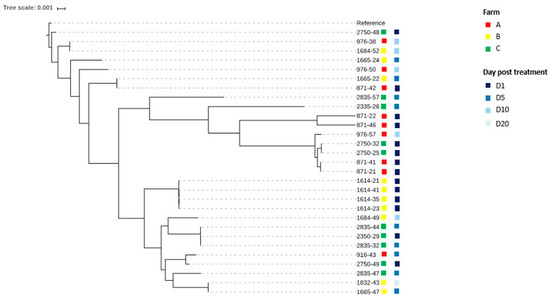
Figure 4.
Maximum likelihood tree on SNPs of newly sequenced genomes of Escherichia coli isolates.
E. coli isolates collected before the antibiotic treatment at D1 shared from 82 to 98,137 SNPs in Farm A, from 44 to 86 SNPs in Farm B and from 109 to 89,968 SNPs in Farm C (Table S3). SNP data confirmed the hypothesis that multiple strains, and not only one, were the causative agents of colisepticemia in all three farms. In particular, in Farm B, SNP calling confirmed the presence at D1 of genetically related strains (all belonging to O78-ST23-H35), which probably share a common ancestor. As was the case for PFGE, also with SNPs, the higher genetic diversity among strains collected from D5 to D10 in comparison to D1 is confirmed (Figure 4 and Table S3).
3.5.2. Characterization of Genetic Determinants of Enrofloxacin Resistance
All enrofloxacin-resistant and intermediate-sequenced genomes carried two or more point mutations in the gyrA gene (S83L and D87N), the parC gene (S80R, S80I and E84G) or the parE gene (S458A). One genome collected at D5 in Farm B (1665-24) and two genomes collected at D1 (2750-48) and D5 (2835-47) in Farm C carried additional plasmid-mediated quinolone resistance (PMQR)-determinant genes qnrB19 and qnrS1 (Table 4). Both the identification of genes in associations to detected mutations as well as the identification of one or more detected mutations have already been described as associated with fluoroquinolone resistance [44].

Table 4.
Fluoroquinolone resistance phenotypes and genotypes of newly sequenced E. coli genomes.
3.5.3. In Silico Resistome Characterization
Regarding antimicrobial resistance determinants other than fluorquinolone ones, sequenced genomes carried genes predicting multiresistance phenotypes (resistance to more than three antimicrobial agents) (Figure 5). In particular, except for the four D1 genomes of isolates collected at D1 in Farm B (ID 1614) predicted as resistant to aminoglycosides (acc(3)-IId) and β-lactams (blaTEM-1B), all genomes tested showed the co-occurrence of different antimicrobial-resistant-determinant genes predicting resistance against aminoglycosides (aac(3)-IId, aadA, ant(3”)-Ia, aph(3”)-Ib and aph(6)-Id), β-lactams (blaTEM), chloramphenicol (catA and clmA), trimethoprim (dfrA), lincosamides (lnu), sulphonamides (sul1, sul2 and sul3) and/or tetracycline (tet(34), tet(A) and tet(B)). Interestingly, multiresistant predicting genotypes were found both before and after the enrofloxacin treatment. This indication suggests that antimicrobial resistance genes circulated all along the period under study, independently from the enrofloxacin treatment and leading to the hypothesis of a potential dissemination of those determinants from the D1 population to the D5, D10 and D24 E. coli populations through the horizontal transfer of plasmids carrying those genes.
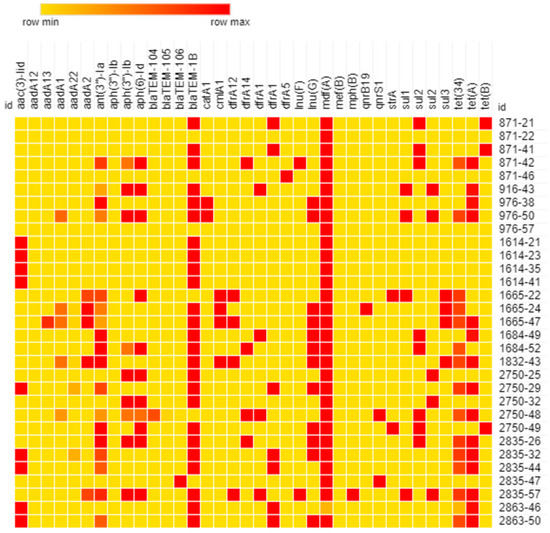
Figure 5.
Heatmap of antimicrobial resistance genes in newly sequenced E. coli genomes (identity from 0% (yellow) to 100% (red)).
3.5.4. Localization of Antimicrobial Resistance Genes
The majority of antimicrobial-resistance-associated genes were located on plasmids (Table 5). Most of the plasmid-mediated genes were conjugative or mobilizable (Table 5).

Table 5.
Localization of antimicrobial-resistance-associated genes.
Regarding plasmid-mediated quinolone resistance (PMQR), qnrB19 was located in a mobilizable plasmid and qnrS1 in two conjugative plasmids (Table 5).
The qnrB19-carrying contig of 2744 bp showed a 98% coverage and 100% identity with the plasmid pRIVM_C014947_7 found in one strain of Klebsiella pneumoniae (accession number MT560070.1) and plasmid pUWI-PP122.1 found in one strain of Salmonella enterica (accession number CP066326.1) (Figure 6).
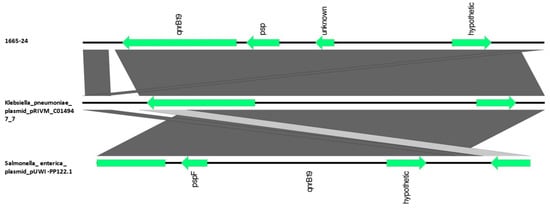
Figure 6.
BLAST alignment of qnrB19-carrying contig in E. coli strain 1665-24 with plasmid pRIVM_C014947_7 (Klebsiella pneumoniae MT560070.1) and plasmid pUWI-PP122.1 (Salmonella enterica CP066326.1), performed and visualized with Easyfig 2.2.5 (https://mjsull.github.io/Easyfig/ (accessed on 28 July 2023)).
The qnrS1-carrying contigs of isolate 2750-48 and isolate 2835-47 showed a 100% coverage and 99,98% identity with plasmid sequences of Klebsiella flexneri (accession numbers CP012734.1 and CP020341.1), E. coli (accession number MH121702.1) and Salmonella enterica serovar Dessau (accession number CP043765.1). The quinolone-resistance-carrying contigs (qnrS1 and qnrB19) are displayed in Figure 7; notably, the qnrS1 gene harboured by the 2835-47 strain is located in one integron closely located to a Tn3 transposon carrying the blaTEM gene (Figure 7).
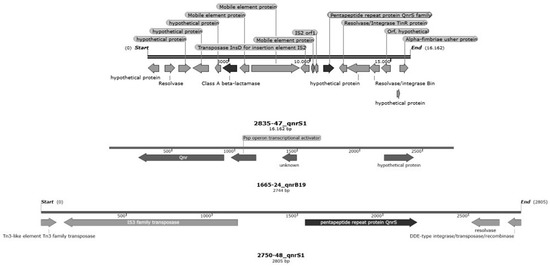
Figure 7.
Quinolone-resistance-carrying contigs harboured by E. coli strains (qnrS1-carrying contigs of E. coli 2835-47 and 2750-48, and qnrB19-carrying contig of E. coli 1665-24).
Interestingly, plasmid clusters AB233 in Farm A and AA474 in Farms B and C showed persistence, being identified both before (D1) and after (D5 and/or D10) the antimicrobial treatment (Table 5). Plasmid cluster AB233 harboured blaTEM-1B, catA and tet(A) genes. The AA474 plasmid cluster carried blaTEM-1B, aac(3)-IId, sul2 and dfrA1 associated, respectively, with β-lactam, aminoglycoside and trimethoprim/sulphonamide resistance. None of the two plasmid clusters harboured fluroquinolone-resistance-determinant genes.
4. Discussion
In the present study, the genetic diversity and antimicrobial resistance of E. coli isolated from the spleen, pericardium, lungs and cns during enrofloxacin therapy on broilers affected by colicepticemia were evaluated. In three conventional farms, a clear temporal variation of the E. coli population was observed. Along the treatment, the number of E. coli isolates collected from extraintestinal organs decreased and the E. coli diversity population increased with a disappearance of the predominant genotypes identified before the treatment and the emergence of new diverse genotypes. This higher genetic diversity might be associated with the disappearance of the pathogenic clone and the emergence of different apathogenic E. coli ones. The disappearance of pathological lesions on selected organs after the treatment reinforces this hypothesis.
Whilst serotyping still represents the most applied diagnostic method for APEC identification, only 29% of the isolates positively reacted with commercial antisera, confirming 078 as the most reported serotype (77% of typable strains). The high rate of untypable isolates observed in this study is consistent with other reports [17,20], addressing various limitations to the implementation of serotyping as an effective diagnostic tool. However, the whole-genome sequencing approach carried out on a representative subset of 31 strains allowed for the identification and subtyping of APEC strains with a greater accuracy than the conventional serotyping methods. Within D1 E. coli isolates, two ST types were the most represented: ST117 and ST23. ST117 has been observed in broilers and breeders in Nordic poultry production [22]. APEC and UPEC isolates, belonging to ST117, have been described, suggesting this ST as potentially zoonotic [12]. Similarly, based on their genome content, two ST23 APEC isolates were more closely related to the genomes of human enterotoxigenic ST23 E. coli than to APEC O1-ST95 [16].
Regarding antimicrobial resistance, in all farms, high percentages of E. coli strains were resistant to beta-lactams, fluoroquinolones, tetracycline and trimethoprim/sulphamethoxazole. Those resistances are in line with the use of these antimicrobials in poultry in the whole EU [23]. Further studies on antibiotic-free farms will be interesting to compare the occurrence of antimicrobial resistance phenotypes and genotypes.
An increasing trend of enrofloxacin-resistant isolates was detected from D1 to D10. This observation suggests that enrofloxacin therapy selected fluoroquinolone-resistant E. coli isolates (cut-offs R ≥ 2 (mg/L)). Further studies on a longer period of time post-treatment are required to investigate whether those selected resistant phenotypes persist over time in the absence of a selective pressure.
According to WGS results, point mutations were detected in all enrofloxacin-resistant sequenced isolates. In particular, mutations were found in the gyrA gene, the parC gene and the parE gene. The combination of these mutations has been known to be associated with fluoroquinolone resistance for many years [45]. Along with these mutations, three isolates carried qnrB19 or qnrS1 genes. The qnr genes were previously detected in S. enterica, E. coli, Klebsiella pneumoniae and other clinical and environmental isolates [46,47,48]. Although rarely found in the past, in more recent years, they are re-emerging as a concern due to their increased frequency of detection in some countries [48]. Moreover, although associated with a phenotype of a reduced susceptibility in the absence of additional QRDR mutations, they have been recently associated with clinical resistance to ciprofloxacin under urinary tract physiological conditions [49].
The majority of antimicrobial-resistance-associated genes detected in the present study were localized in conjugative or mobilizable plasmids, suggesting their potential spread to other bacteria with horizontal gene transfer. Interestingly, two plasmid clusters, carrying beta-lactam, tetracycline and trimethoprim/sulphametoxazole resistance genes but not fluoroquinolone resistance ones, were found as repeatedly isolated before and after the antimicrobial treatment, suggesting the persistence and spread of these plasmids. The persistence of plasmids without a corresponding antimicrobial selection pressure has been addressed as the plasmid paradox [50]. If, on one side, without a selective pressure, costly plasmids should be lost over time, the current study confirms (in vivo) that plasmids can persist, even in the absence of positive selection, as was already observed in vitro [51,52,53]. Further studies will be needed to clearly evaluate the persistence of those plasmids in a longer time period as well as to decipher the molecular bases of these observations.
5. Conclusions
In conclusion, in the present work, the population of extraintestinal E. coli during and after the antimicrobial treatment in broilers affected by colisepticemia revealed an increasing genetic diversity. Interestingly, phylogenetic and genomic analyses did not reveal the persistence of one strain all along the study period, suggesting that the extraintestinal enrofloxacin-susceptible E. coli population found before the treatment left room for the colonization of a new and more diverse enrofloxacin-resistant E. coli population. If isolates did not persist, AMR plasmid did. Genomic analyses revealed the persistence of two conjugative plasmid clusters, suggesting that the enrofloxacin treatment was effective in eradicating the initial extraintestinal E. coli population; however, plasmids carried by this population were able to persist and spread to the extraintestinal population found after the treatment.
Supplementary Materials
The following supporting information can be downloaded at: https://www.mdpi.com/article/10.3390/ani13162590/s1, Table S1: Statistics of the 31 newly sequenced whole genomes of E. coli; Table S2: Metadata of newly sequenced E. coli genomes of broiler isolates; Table S3: SNP distance matrix of newly sequenced E. coli genomes.
Author Contributions
Conceptualization, F.P. and G.M.; methodology, A.L. and A.P.; investigation, C.C. and L.G.; resources, M.S.; data curation, D.R. and A.M.; writing—original draft preparation, F.P.; writing—review and editing, F.P. and G.M. All authors have read and agreed to the published version of the manuscript.
Funding
This study was partially funded by Bayer Animal Health.
Institutional Review Board Statement
Samples and data were collected as part of veterinary inspection procedures in commercial broiler farms in Italy. Sick animals were humanly euthanized by farm veterinarians via cervical dislocation following Regulation (CE) 1099/2009. Samples and data were collected on a broiler nucleus only, and this is a non-experimental, agricultural practice. The Italian law Lgs 26/2014, as the implementation of Directive 2010/63/EU of the European Parliament on the protection of animals used for scientific purposes, does not apply to non-experimental, agricultural practices. An ethical review by the Animal Welfare Committee of the university was therefore not required. No extra animal discomfort was caused for sample collection for the purpose of this study.
Data Availability Statement
Read sequences are available at the European Nucleotide Archive under the study accession number PRJEB36793.
Conflicts of Interest
The funder had no role in the design of the study; in the collection, analyses or interpretation of data; in the writing of the manuscript; or in the decision to publish the results.
References
- Guabiraba, R.; Schouler, C. Avian colibacillosis: Still many black holes. FEMS Microbiol. Lett. 2015, 362, fnv118. [Google Scholar] [CrossRef] [PubMed]
- Landman, W.J.M.; van Eck, J.H.H. The incidence and economic impact of the Escherichia coli peritonitis syndrome in Dutch poultry farming. Avian Pathol. 2015, 44, 370–378. [Google Scholar] [CrossRef]
- Abu Daud, N.H.b.; Htin, N.N.; Abba, Y.; Paan, F.H.; Kyaw, T.; Khaing, A.T.; Abdullah, F.F.J.; Mohammed, K.; Adamu, L.; Tijjani, A. An outbreak of colibacillosis in a broiler farm. J. Vet. Adv. 2014, 4, 648–653. [Google Scholar] [CrossRef]
- Maciel, J.F.; Matter, L.B.; Trindade, M.M.; Camillo, G.; Lovato, M.; de Ávila Botton, S.; Castagna de Vargas, A. Virulence factors and antimicrobial sus-ceptibility profile of extraintestinal Escherichia coli isolated from an avian colisepticemia outbreak. Microb. Pathog. 2017, 103, 119–122. [Google Scholar] [CrossRef]
- Rashid, M.H.; Xue, C.; Islam, M.R.; Islam, M.; Cao, Y. A longitudinal study on the incidence of mortality of infectious diseases of commercial layer birds in Bangladesh. Prev. Vet. Med. 2013, 109, 354–358. [Google Scholar] [CrossRef]
- Stokholm, N.M.; Permin, A.; Bisgaard, M.; Christensen, J.P. Causes of mortality in commercial organic layers in Denmark. Avian Dis. 2010, 54, 1241–1250. [Google Scholar] [CrossRef] [PubMed]
- Vandekerchove, D.; De Herdt, P.; Laevens, H.; Pasmans, F. Colibacillosis in caged layer hens: Characteristics of the disease and the aetiological agent. Avian Pathol. 2004, 33, 117–125. [Google Scholar] [CrossRef]
- Zanella, A.; Alborali, G.L.; Bardotti, M.; Candotti, P.; Guadagnini, P.F.; Martino, P.A.; Stonfer, M. Severe Escherichia coli O111 septi-caemia and polyserositis in hens at the start of lay. Avian Pathol. 2000, 29, 311–317. [Google Scholar] [CrossRef] [PubMed]
- Johnson, T.J.; Nolan, L.K. Pathogenomics of the virulence plasmids of Escherichia coli. Microbiol. Mol. Biol. Rev. 2009, 73, 750–774. [Google Scholar] [CrossRef]
- LeStrange, K.; Markland, S.M.; Hoover, D.G.; Sharma, M.; Kniel, K.E. An evaluation of the virulence and adherence properties of avian pathogenic Escherichia coli. One Health 2017, 4, 22–26. [Google Scholar] [CrossRef]
- Stromberg, Z.R.; Johnson, J.R.; Fairbrother, J.M.; Kilbourne, J.; Van Goor, A.; Curtiss, R., 3rd; Mellata, M. Evaluation of Escherichia coli isolates from healthy chickens to determine their potential risk to poultry and human health. PLoS ONE 2017, 12, e0180599. [Google Scholar] [CrossRef] [PubMed]
- Dissanayake, D.; Octavia, S.; Lan, R. Population structure and virulence content of avian pathogenic Escherichia coli isolated from outbreaks in Sri Lanka. Vet. Microbiol. 2014, 168, 403–412. [Google Scholar] [CrossRef] [PubMed]
- Pasquali, F.; Lucchi, A.; Braggio, S.; Giovanardi, D.; Franchini, A.; Stonfer, M.; Manfreda, G. Genetic diversity of Escherichia coli isolates of animal and environmental origins from an integrated poultry production chain. Vet. Microbiol. 2015, 178, 230–237. [Google Scholar] [CrossRef] [PubMed]
- Fratamico, P.M.; DebRoy, C.; Liu, Y.; Needleman, D.S.; Baranzoni, G.M.; Feng, P. Advances in molecular serotyping and subtyping of Escherichia coli. Front. Microbiol. 2016, 7, 644. [Google Scholar] [CrossRef]
- Landman, W.J.M.; Buter, G.J.; Dijkman, R.; Van Eck, J.H.H. Molecular typing of avian pathogenic Escherichia coli colonies origi-nating from outbreaks of E. coli peritonitis syndrome in chicken flocks. Avian Pathol. 2014, 43, 345–356. [Google Scholar] [CrossRef][Green Version]
- Huja, S.; Oren, Y.; Trost, E.; Brzuszkiewicz, E.; Biran, D.; Blom, J.; Goesmann, A.; Gottschalk, G.; Hacker, J.; Ron, E.Z.; et al. Genomic avenue to avian colisepticemia. MBio 2015, 6, e01681-14. [Google Scholar] [CrossRef]
- Cordoni, G.; Woodward, M.J.; Wu, H.; Alanazi, M.; Wallis, T.; La Ragione, R.M. Comparative genomics of European avian pathogenic E. coli (APEC). BMC Genom. 2016, 17, 960. [Google Scholar] [CrossRef]
- Rosario, C.C.; López, C.C.; Téllez, I.G.; Navarro, O.A.; Anderson, R.C.; Eslava, C.C. Serotyping and virulence genes detection in Escherichia coli isolated from fertile and infertile eggs, dead-in-shell embryos, and chickens with yolk sac infection. Avian Dis. 2004, 48, 791–802. [Google Scholar] [CrossRef]
- Wang, X.; Cao, C.; Huan, H.; Zhang, L.; Mu, X.; Gao, Q.; Dong, X.; Gao, S.; Liu, X. Isolation, identification, and pathogenicity of O142 avian pathogenic Escherichia coli causing black proventriculus and septicemia in broiler breeders. Infect. Genet. Evol. 2015, 32, 23–29. [Google Scholar] [CrossRef]
- Zhao, S.H.; Maurer, J.J.; Hubert, S.; De Villena, J.F.; McDermott, P.F.; Meng, J.; Ayers, S.; English, L.; White, D.G. Antimicrobial susceptibility and molecular characterization of avian pathogenic Escherichia coli isolates. Vet. Microbiol. 2005, 107, 215–224. [Google Scholar] [CrossRef]
- Cummins, M.L.; Reid, C.J.; Roy Chowdhury, P.; Bushell, R.N.; Esbert, N.; Tivendale, K.A.; Noormohammadi, A.H.; Islam, S.; Marenda, M.S.; Browning, G.F.; et al. Whole genome sequence analysis of Australian avian pathogenic Escherichia coli that carry the class 1 integrase gene. Microb. Genom. 2019, 5, e000250. [Google Scholar] [CrossRef] [PubMed]
- Ronco, T.; Stegger, M.; Olsen, R.H.; Sekse, C.; Nordstoga, A.B.; Pohjanvirta, T.; Lilje, B.; Lyhs, U.; Andersen, P.S.; Pedersen, K. Spread of avian pathogenic Escherichia coli ST117 O78: H4 in Nordic broiler production. BMC Genom. 2017, 18, 13. [Google Scholar] [CrossRef]
- Roth, N.; Käsbohrer, A.; Mayrhofer, S.; Zitz, U.; Hofacre, C.; Domig, K.J. The application of antibiotics in broiler production and the resulting antibiotic resistance in Escherichia coli: A global overview. Poult. Sci. 2019, 98, 1791–1804. [Google Scholar] [CrossRef] [PubMed]
- Cavicchio, L.; Dotto, G.; Giacomelli, M.; Giovanardi, D.; Grilli, G.; Franciosini, M.P.; Trocino, A.; Piccirillo, A. Class 1 and class 2 integrons in avian pathogenic Escherichia coli from poultry in Italy. Poult. Sci. 2015, 94, 1202–1208. [Google Scholar] [CrossRef] [PubMed]
- Giovanardi, D.; Lupini, C.; Pesente, P.; Rossi, G.; Ortali, G.; Catelli, E. Characterization and antimicrobial resistance analysis of avian pathogenic Escherichia coli isolated from Italian turkey flocks. Poult. Sci. 2013, 92, 2661–2667. [Google Scholar] [CrossRef]
- Nhung, N.T.; Chansiripornchai, N.; Carrique-Mas, J.J. Antimicrobial resistance in bacterial poultry pathogens: A review. Front. Vet. Sci. 2017, 4, 126. [Google Scholar] [CrossRef]
- Dheilly, A.; Le Devendec, L.; Mourand, G.; Jouy, E.; Kempf, I. Antimicrobial resistance selection in avian pathogenic E. coli during treatment. Vet. Microbiol. 2013, 166, 655–658. [Google Scholar] [CrossRef]
- Ørskov, F.; Ørskov, I. Serotyping of Escherichia coli. Methods Microbiol. 1984, 14, 43–112. [Google Scholar] [CrossRef]
- Ribot, E.M.; Fair, M.A.; Gautom, R.; Cameron, D.N.; Hunter, S.B.; Swaminathan, B.; Barrett, T.J. Standardization of pulsed-field gel electro-phoresis protocols for the subtyping of Escherichia coli O157: H7, Salmonella, and Shigella for PulseNet. Foodborne Pathog. Dis. 2006, 3, 59–67. [Google Scholar] [CrossRef]
- Gibson, J.R.; Sutherland, K.; Owen, R.J. Inhibition of DNAse activity in PFGE analysis of DNA from Campylobacter jejuni. Lett. Appl. Microbiol. 1994, 19, 357–358. [Google Scholar] [CrossRef]
- Clinical and Laboratory Standards Institute (CLSI). Performance Standards for Antimicrobial Disk and Dilution Susceptibility Tests for Bacteria Isolated From Animals; Approved Standard, 3rd ed.; CLSI document M31-A3; Clinical and Laboratory Standards Institute: Wayne, PA, USA, 2008; ISBN 1-56238-659-X. [Google Scholar]
- INNUca. Available online: https://github.com/B-UMMI/INNUca (accessed on 16 June 2023).
- ABRicate. Available online: https://github.com/tseemann/abricate (accessed on 16 June 2023).
- Zankari, E.; Allesøe, R.; Joensen, K.; Cavaco, L.M.; Lund, O.; Aarestrup, F.M. PointFinder: A novel web tool for WGS-based detection of antimicrobial resistance associated with chromosomal point mutations in bacterial pathogens. J. Antimicrob. Chemother. 2017, 72, 2764–2768. [Google Scholar] [CrossRef] [PubMed]
- Roer, L.; Tchesnokova, V.; Allesoe, R.; Muradova, M.; Chattopadhyay, S.; Ahrenfeldt, J.; Thomsen, M.C.F.; Lund, O.; Hansen, F.; Hammerum, A.M.; et al. Development of a web tool for Escherichia coli subtyping based on fimh alleles. J. Clin. Microbiol. 2017, 55, 2538–2543. [Google Scholar] [CrossRef] [PubMed]
- Whole Genome Sequencing Data Web Tools: Centre for Genomic Epidemiology. Available online: https://cge.cbs.dtu.dk/services/FimTyper/ (accessed on 16 June 2023).
- Robertson, J.; Nash, J.H.E. MOB-suite: Software tools for clustering, reconstruction and typing of plasmids from draft assem-blies. Microb. Genom. 2018, 4, e000206. [Google Scholar] [CrossRef]
- Snippy. Available online: https://github.com/tseemann/snippy (accessed on 16 June 2023).
- Letunic, I.; Bork, P. Interactive Tree Of Life (iTOL) v5: An online tool for phylogenetic tree display and annotation. Nucleic Acids Res. 2021, 49, W293–W296. [Google Scholar] [CrossRef] [PubMed]
- Pairwise SNP Distance Matrix. Available online: https://github.com/tseemann/snp-dists (accessed on 16 June 2023).
- Jiang, L.; Yang, W.; Jiang, X.; Yao, T.; Wang, L.; Yang, B. Virulence-related O islands in enterohemorrhagic Escherichia coli O157:H7. Gut Microbes 2021, 13, 1992237. [Google Scholar] [CrossRef]
- Bojesen, A.M.; Ahmed, U.; Skaarup, H.; Espinosa-Gongora, C. Recurring outbreaks by the same Escherichia coli ST10 clone in a broiler unit during 18 months. Vet. Res. 2022, 53, 2. [Google Scholar] [CrossRef]
- Núñez-Samudio, V.; Pecchio, M.; Pimentel-Peralta, G.; Quintero, Y.; Herrera, M.; Landires, I. Molecular Epidemiology of Escherichia coli Clinical Isolates from Central Panama. Antibiotics 2021, 10, 899. [Google Scholar] [CrossRef]
- Jacoby, G.A.; Strahilevitz, J.; Hooper, D.C. Plasmid-mediated quinolone resistance. Microbiol. Spectr. 2014, 2. [Google Scholar] [CrossRef]
- Hopkins, K.L.; Davies, R.H.; Threlfall, E.J. Mechanisms of quinolone resistance in Escherichia coli and Salmonella: Recent de-velopments. Int. J. Antimicrob. Agents 2005, 25, 358–373. [Google Scholar] [CrossRef]
- Schink, A.K.; Kadlec, K.; Schwarz, S. Detection of qnr genes among Escherichia coli isolates of animal origin and complete se-quence of the conjugative qnrB19-carrying plasmid pQNR2078. J. Antimicrob. Chemother. 2012, 67, 1099–1102. [Google Scholar] [CrossRef]
- Fiegen, U.; Klein, G.; de Jong, A.; Kehrenberg, C. Detection of a Novel qnrB19-Carrying Plasmid Variant Mediating Decreased Fluoroquinolone Susceptibility in Salmonella enterica Serovar Hadar. Microb. Drug Resist. 2017, 23, 280–284. [Google Scholar] [CrossRef]
- Richter, S.N.; Frasson, I.; Bergo, C.; Manganelli, R.; Cavallaro, A.; Palù, G. Characterisation of qnr plasmid-mediated quinolone re-sistance in Enterobacteriaceae from Italy: Association of the qnrB19 allele with the integron element ISCR1 in Escherichia coli. Int. J. Antimicrob. Agents 2010, 35, 578–783. [Google Scholar] [CrossRef]
- Martín-Gutiérrez, G.; Rodríguez-Martínez, J.M.; Pascual, Á.; Rodríguez-Beltrán, J.; Blázquez, J. Plasmidic qnr Genes Confer Clinical Resistance to Ciprofloxacin under Urinary Tract Physiological Conditions. Antimicrob. Agents Chemother. 2017, 61, e02615–e02616. [Google Scholar] [CrossRef]
- Carroll, A.C.; Wong, A. Plasmid persistence: Costs, benefits, and the plasmid paradox. Can. J. Microbiol. 2018, 64, 293–304. [Google Scholar] [CrossRef] [PubMed]
- Cottell, J.L.; Webber, M.A.; Piddock, L.J.V. Persistence of transferable extended-spectrum-β-lactamase resistance in the absence of antibiotic pressure. Antimicrob. Agents Chemother. 2012, 56, 4703–4706. [Google Scholar] [CrossRef] [PubMed]
- Fischer, E.A.J.; Dierikx, C.M.; van Essen-Zandbergen, A.; van Roermund, H.J.W.; Mevius, D.J.; Stegeman, A.; Klinkenberg, D. The IncI1 plasmid carrying the blaCTX-M-1 gene persists in in vitro culture of an Escherichia coli strain from broilers. BMC Microbiol. 2014, 14, 77. [Google Scholar] [CrossRef] [PubMed]
- Porse, A.; Schønning, K.; Munck, C.; Sommer, M.O.A. Survival and evolution of a large multidrug resistance plasmid in new clinical bacterial hosts. Mol. Biol. Evol. 2016, 33, 2860–2873. [Google Scholar] [CrossRef]
Disclaimer/Publisher’s Note: The statements, opinions and data contained in all publications are solely those of the individual author(s) and contributor(s) and not of MDPI and/or the editor(s). MDPI and/or the editor(s) disclaim responsibility for any injury to people or property resulting from any ideas, methods, instructions or products referred to in the content. |
© 2023 by the authors. Licensee MDPI, Basel, Switzerland. This article is an open access article distributed under the terms and conditions of the Creative Commons Attribution (CC BY) license (https://creativecommons.org/licenses/by/4.0/).